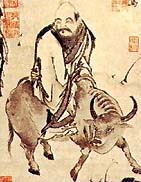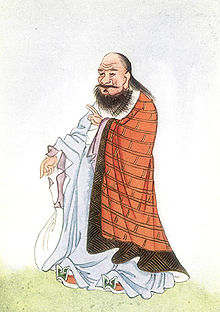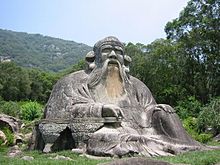
Laozi
Did you know...
This Wikipedia selection is available offline from SOS Children for distribution in the developing world. See http://www.soschildren.org/sponsor-a-child to find out about child sponsorship.
 Laozi, depicted as a Taoist leader. |
|
| Born | Zhou Dynasty |
|---|---|
| Died | Zhou Dynasty |
| Era | Ancient philosophy |
| Region | East Asia |
| School | Taoism |
| Notable ideas | Wu wei |
Laozi (see other names and spelling variations; Chinese: 老子, English pronunciation: / ˌ l aʊ ˈ d z ʌ /; fl. 6th century BCE) was a philosopher of ancient China, best known as the author of the Tao Te Ching (often simply referred to as Laozi). His association with the Tào Té Chīng has led him to be traditionally considered the founder of philosophical Taoism (pronounced as "Daoism"). He is also revered as a deity in most religious forms of Taoist philosophy, which often refers to Laozi as Taishang Laojun, or "One of the Three Pure Ones".
According to Chinese traditions, Laozi lived in the 6th century BCE. Some historians contend that he actually lived in the 5th–4th century BCE, concurrent with the Hundred Schools of Thought and Warring States Period, while some others argue that Laozi is a synthesis of multiple historical figures or that he is a mythical figure.
A central figure in Chinese culture, both nobility and common people claim Laozi in their lineage. He was honored as an ancestor of the Tang imperial family, and was granted the title Táishāng xuānyuán huángdì, meaning "Supreme Mysterious and Primordial Emperor". Throughout history, Laozi's work has been embraced by various anti-authoritarian movements.
Names
"Laozi" (Chinese: 老子; pinyin: Lǎozǐ) is an honorific title, also romanized as Lao Tse, Lao Tu, Lao-Tsu, Laotze, Laosi, Laocius, etc. Lao ( 老) means "venerable" or "old", such as modern Mandarin laoshi ( 老师), "teacher". Zi ( 子), Wade-Giles transliteration tzu, in this context is typically translated "master". Zi was used in ancient China as an honorific suffix, indicating "Master", or "Sir". In popular biographies, Laozi's given name was Er, his surname was Li (forming Li Er, 李 耳) and his courtesy name was Boiang. Dan is a posthumous name given to Laozi, and he is sometimes referred to as Li Dan ( 李 聃).
Historical views
The earliest reliable reference (circa 100 BCE) to Laozi is found in the Records of the Grand Historian ( Shiji) by Chinese historian Sima Qian (ca. 145-86 BCE), which combines a number of stories. In the first, Laozi was said to be a contemporary of Confucius (551-479 BCE). His surname was Li (李 "plum"), and his personal name was Er (耳 "ear") or Dan (聃 "long ear"). He was an official in the imperial archives, and wrote a book in two parts before departing to the West. In the second, Laozi was Lao Laizi (老莱子 "Old Master"), also a contemporary of Confucius, who wrote a book in 15 parts. In the third, Laozi was the Grand Historian and astrologer Lao Dan (老聃 "Old Long-ears"), who lived during the reign (384-362 BCE) of Duke Xiàn (獻公) of Qin.
The oldest known text of the Tao Te Ching that has been excavated was written on bamboo tablets and dates back to the late 4th century BC.
In the mid-twentieth century a consensus had emerged among scholars that the historicity of Laozi was doubtful or unprovable and that the Tao Te Ching was "a compilation of Taoist sayings by many hands." Alan Watts (1975) held that this view was part of an academic fashion for skepticism about historical spiritual and religious figures, arguing that not enough would be known for years, or possibly ever, to make a firm judgment.
According to popular traditional biographies, Laozi worked as the Keeper of the Archives for the royal court of Zhou, and was a scholar (shown in many Lao Zi paintings). This reportedly allowed him broad access to the works of the Yellow Emperor and other classics of the time. The stories assert that Laozi never opened a formal school, but he nonetheless attracted a large number of students and loyal disciples. There are numerous variations of a story depicting Confucius consulting Laozi about rituals and the story is related in Zhuangzi (though the author of Zhuangzi may have invented both the story and the character of Laozi).
Popular legends tell of his conception when his mother gazed upon a falling star, how he stayed in the womb for 62 years, and was born when his mother leaned against a plum tree. He accordingly emerged a grown man with a full grey beard and long earlobes, which are a symbol of wisdom and long life. In other versions he was reborn in some thirteen incarnations since the days of Fuxi; in his last incarnation as Laozi he lived to nine hundred and ninety years, and spent his life traveling to reveal the Dao.

Many of the popular accounts say that Laozi was married and had a son named Zong, who became a celebrated soldier. A large number of people trace their lineage back to Laozi, as did the emperors of the Tang Dynasty. According to Simpkins & Simpkins, while many (if not all) of the lineages are inaccurate, they provide a testament to the impact of Laozi on Chinese culture.
The third story Sima Qian drew on states that Laozi grew weary of the moral decay of city life and noted the kingdom's decline. According to these legends, he ventured west to live as a hermit in the unsettled frontier at the age of 160. At the western gate of the city, or kingdom, he was recognized by a guard, Yinxi (Wade Giles Yin Hse).
The sentry asked the old master to produce a record of his wisdom. This is the legendary origin of the Daodejing. In some versions of the tale, the sentry is so touched by the work that he leaves with Laozi, never to be seen again. Some legends elaborate further that the "Old Master" was the teacher of the Siddartha Gautama, better known as the Buddha, or was even the Buddha himself.
Laozi's relationship with Yinxi is the subject of numerous legends. It is Yinxi who asked Laozi to write down his wisdom in the traditional account of the Daodejing's creation. The story of Laozi transmitting the Daodejing to Yinxi is part of a broader theme involving Laozi the deity delivering salvific truth to a suffering humanity. Regardless, the deliverance of the Daodejing was the ultimate purpose of his human incarnation. Folklore developed around Laozi and Yinxi to demonstrate the ideal interaction of Taoist master and disciple.
A seventh century work, Sandong zhunang ("Pearly Bag of the Three Caverns"), provides one account of their relationship. Laozi pretended to be a farmer when reaching the western gate, but was recognized by Yinxi, who asked to be taught by the great master. Laozi was not satisfied by simply being noticed by the guard and demanded an explanation. Yinxi expressed his deep desire to find the Tao and explained that his long study of astrology allowed him to recognize Laozi's approach. Yinxi was accepted by Laozi as a disciple. This is considered an exemplary interaction between Daoist master and disciple, reflecting the testing a seeker must undergo before being accepted. A would-be adherent is expected to prove his determination and talent, clearly expressing his wishes and showing that he had made progress on his own towards realizing the Tao.
The Pearly Bag of the Three Caverns continues the parallel of an adherent's quest. Yinxi received his ordination when Laozi transmitted the Daodejing, along with other texts and precepts, just as Taoist adherents receive a number of methods, teachings and scriptures at ordination. This is only an initial ordination and Yinxi still needed an additional period to perfect his faith, thus Laozi gave him three years to perfect his Dao. Yinxi gave himself over to a full-time devotional life. After the appointed time, Yinxi again demonstrates determination and perfect trust, sending out a black sheep to market as the agreed sign. He eventually meets again with Laozi, who announces that Yinxi's immortal name is listed in the heavens and calls down a heavenly procession to clothe Yinxi in the garb of immortals. The story continues that Laozi bestowed a number of titles upon Yinxi and took him on a journey throughout the universe, even into the nine heavens. After this fantastic journey, the two sages set out to western lands of the barbarians. The training period, reuniting and travels represent the attainment of the highest religious rank in medieval Taoism called "Preceptor of the Three Caverns". In this legend, Laozi is the perfect Daoist master and Yinxi is the ideal Taoist student. Laozi is presented as the Tao personified, giving his teaching to humanity for their salvation. Yinxi follows the formal sequence of preparation, testing, training and attainment.
The story of Laozi has taken on strong religious overtones since the Han dynasty. As Daoism took root, Laozi was recognized as a god. Belief in the revelation of the Dao from the divine Laozi resulted in the formation of the Way of the Celestial Master, the first organized religious Daoist sect. In later mature Daoist tradition, Laozi came to be seen as a personification of Dao. He is said to have undergone numerous "transformations", or taken on various guises in various incarnations throughout history to initiate the faithful in the Way. Religious Daoism often holds that the "Old Master" did not disappear after writing the Daodejing, but rather spent his life traveling to reveal the Dao.
Lao Tzu was born in the village of Chu Jen in the Kingdom of Ch'u. (He may have been born sometime in the sixth century B.C.E. [Before the Common Era]. Traditionally, he is said to have lived at the same time as Confucius, but recent scholars place him about two centuries later.) Lao Tzu spent most of his life as an archivist in the library of the Zhou Dynasty court, a boring job that gave him lots of time to think. He quit when he saw things were getting corrupt, and then went into exile. Lao Tzu became disturbed by the corruption he saw everywhere around him and decided to take the easy way out- literally, and leave the country. He traveled west on a water buffalo to reach the great desert. At the westernmost gate, a guard who recognized him, demanded that he write down his teachings, unrecorded until this point. The collected teachings became the Tao Te Ching.
Tao Te Ching
Laozi is traditionally regarded as the author of the Daodejing (Tao Te Ching), though the identity of its author(s) and/or compiler(s) has been debated throughout history. It is one of the most significant treatises in Chinese cosmogony. As with most other ancient Chinese philosophers, Laozi often explains his ideas by way of paradox, analogy, appropriation of ancient sayings, repetition, symmetry, rhyme, and rhythm. In fact, the whole book can be read as an analogy - the ruler is the awareness, or self, in meditation and the myriad creatures or empire is the experience of the body, senses and desires. Passages such as "Block the openings, shut the doors" and "the sage who does nothing never ruins anything" refer to sitting in meditation. "Keep the people ignorant" means do not pay attention to the senses and thoughts.
The Tao Te Ching, often called simply Laozi after its reputed author, describes the Dao (or Tao) as the source and ideal of all existence: it is unseen, but not transcendent, immensely powerful yet supremely humble, being the root of all things. According to the Daodejing, humans have no special place within the Dao, being just one of its many ("ten thousand") manifestations. People have desires and free will (and thus are able to alter their own nature). Many act "unnaturally", upsetting the natural balance of the Dao. The Daodejing intends to lead students to a "return" to their natural state, in harmony with Dao. Language and conventional wisdom are critically assessed. Taoism views them as inherently biased and artificial, widely using paradoxes to sharpen the point.
Livia Kohn provides an example of how Laozi encouraged a change in approach, or return to "nature", rather than action. Technology may bring about a false sense of progress. The answer provided by Laozi is not the rejection of technology, but instead seeking the calm state of wu wei, free from desires. This relates to many statements by Laozi encouraging rulers to keep their people in " ignorance", or "simple-minded". Some scholars insist this explanation ignores the religious context, and others question it as an apologetic of the philosophical coherence of the text. It would not be unusual political advice if Laozi literally intended to tell rulers to keep their people ignorant. However, some terms in the text, such as "valley spirit" (gushen) and "soul" (po), bear a metaphysical context and cannot be easily reconciled with a purely ethical reading of the work.
Wu wei (無爲), literally "non-action" or "not acting", is a central concept of the Daodejing. The concept of wu wei is multifaceted, and reflected in the words' multiple meanings, even in English translation; it can mean "not doing anything", "not forcing", "not acting" in the theatrical sense, "creating nothingness", "acting spontaneously", and "flowing with the moment."
It is a concept used to explain ziran (自然), or harmony with the Dao. It includes the concepts that value distinctions are ideological and seeing ambition of all sorts as originating from the same source. Laozi used the term broadly with simplicity and humility as key virtues, often in contrast to selfish action. On a political level, it means avoiding such circumstances as war, harsh laws and heavy taxes. Some Taoists see a connection between wu wei and esoteric practices, such as zuowang "sitting in oblivion" (emptying the mind of bodily awareness and thought) found in the Zhuangzi.
Taoism
Laozi is traditionally regarded as the founder of Taoism, intimately connected with the Daodejing and "primordial" (or "original") Daoism. Popular ("religious") Daoism typically presents the Jade Emperor as the official head deity. Intellectual ("elite") Daoists, such as the Celestial Masters sect, usually present Laozi (Laojun, "Lord Lao") and the Three Pure Ones at the top of the pantheon of deities.
Influence
Eremitism
Zhuāngzi (莊子) is a central authority regarding eremitism, a particular variation of monasticism sacrificing social aspects for religious aspects of life. Zhuāngzi considered eremitism the highest ideal, if properly understood.
Scholars such as Aat Vervoom have postulated that Zhuāngzi advocated a hermit immersed in society. This view of eremitism holds that seclusion is hiding anonymously in society. To a Zhuāngzi hermit, being unknown and drifting freely is a state of mind. This reading is based on the "inner chapters" of the self-titled Zhuangzi.
Scholars such as James Bellamy hold that this could be true and has been interpreted similarly at various points in Chinese history. However, the "outer chapters" of Zhuāngzi have historically played a pivotal role in the advocacy of reclusion. While some scholars state that Laozi was the central figure of Han Dynasty eremitism, historical texts do not seem to support that position.
Politics
Potential officials throughout Chinese history drew on the authority of non-Confucian sages, especially Laozi and Zhuangzi, to deny serving any ruler at any time. Zhuangzi, Laozi's most famous follower in traditional accounts, had a great deal of influence on Chinese literati and culture.
Political theorists influenced by Laozi have advocated humility in leadership and a restrained approach to statecraft, either for ethical and pacifist reasons, or for tactical ends. In a different context, various anti-authoritarian movements have embraced the Laozi teachings on the power of the weak.
The right libertarian economist Murray Rothbard suggested that Laozi was the first libertarian, likening Laozi's ideas on government to F.A. Hayek's theory of spontaneous order. James A. Dorn agreed, writing that Laozi, like many 18th century liberals, "argued that minimizing the role of government and letting individuals develop spontaneously would best achieve social and economic harmony." Similarly, the Cato Institute's David Boaz includes passages from the Daodejing in his 1997 book The Libertarian Reader. Philosopher Roderick Long, however, argues that libertarian themes in Taoist thought are actually borrowed from earlier Confucian writers.
Left libertarians have been highly influenced by Laozi as well. In his 1937 book Nationalism and Culture, the anarcho-syndicalist writer and activist Rudolf Rocker praised Laozi's "gentle wisdom" and understanding of the opposition between political power and the cultural activities of the people and community. In his 1910 article for the Encyclopedia Britannica, Peter Kropotkin also noted that Laozi was among the earliest exponents of essentially anarchist concepts. More recently, anarchists such as John P. Clark and Ursula K. Le Guin have written about the conjunction between anarchism and Taoism in various ways, highlighting the teachings of Laozi in particular. In her translation of the Tao Te Ching, Le Guin writes that Laozi "does not see political power as magic. He sees rightful power as earned and wrongful power as usurped... He sees sacrifice of self or others as a corruption of power, and power as available to anyone who follows the Way. No wonder anarchists and Taoists make good friends."



